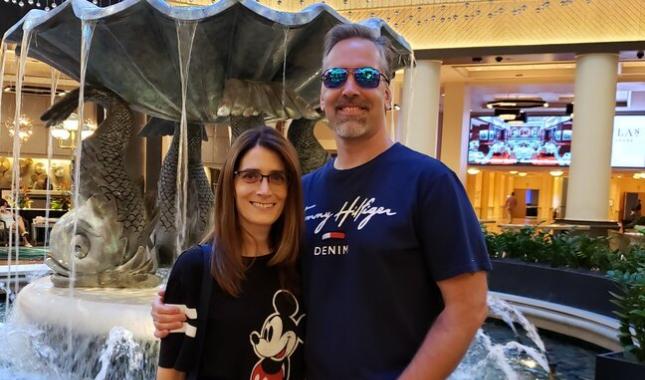(Photo above: Kathy Kaziun and her husband, John.)
When Kathy Kaziun needed surgery to treat a brain aneurysm, she sought the capable hands of Catholic Health Services’s (CHS) Chairman of Neurointerventional Services Kimon Bekelis, MD.
Kaziun would become the first person in New York State and the second in the nation to be treated with a new device known as Surpass Evolve Flow Diverter. This new approach to treating brain aneurysms allows blood to flow away from the aneurysm, giving blood vessels time to heal. Her surgery was performed at CHS’s Good Samaritan Hospital Medical Center in West Islip.
The Surpass Evolve Flow Diverter is a minimally invasive treatment, offering quicker recovery times and shorter hospital stays. A braided stent made of a cobalt-chromium alloy that expands to fit the artery’s contours is deployed via a catheter into the femoral artery in the patient’s groin. Using imaging techniques, the doctor threads the catheter into the brain, installing the stent at the site of the aneurysm. Patients remain in the hospital overnight for observation. Upon discharge the next day, they can resume most of their normal activities right away.
“Stent technology has evolved,” said Dr. Bekelis. “This device provides a more robust system with 64 wires, which allows us to achieve greater flow diversion. Overall, it is a more effective treatment with a gentle delivery system that lets us treat aneurysms in a safer way.”
At 50, Kaziun fits the profile of the typical aneurysm patient. Many are women in their 50s or 60s with no personal or family history or other risk factors. She fully appreciates how fortunate she is to have had her aneurysm diagnosed before it ruptured and to be one of the first patients in the U.S. to be treated using the Surpass Evolve Flow Diverter.
“When it first happened, I was in panic mode,” she said. “But Dr. Bekelis is amazing. I can’t thank him enough. The procedure itself was easier than I expected and not as scary as I imagined it to be.”
Kaziun experienced no pain during or after the procedure. Once home, she had few restrictions other than to avoid heavy lifting. She saw Dr. Bekelis a week later and will have a follow-up visit in six months.
While the Surpass Evolve stent worked in Kaziun’s case, it is not appropriate for every patient. For example, aneurysms located at points where the artery branches off are more appropriately treated with coils or other devices. Also, the stent may not be used in patients whose aneurysms have ruptured.
“For 40 to 60 percent of aneurysms, this will be the ideal treatment,” Dr. Bekelis said, adding that Good Samaritan treats approximately 100 aneurysm patients each year. The Surpass Evolve Stent’s manufacturer selected Dr. Bekelis as one of the first clinicians in the nation to use the device based on the hospital’s extensive experience treating aneurysm patients.
“The volume of patients we treat is a testament to both our dedication and our commitment to innovation in treating brain aneurysm,” Dr. Bekelis said. “Large companies trust us with devices that are newer because of the reputation and experience of our comprehensive stroke center.”
Kaziun said that having the aneurysm effectively treated has given her peace of mind, allowing her to focus on the future. She and her husband, John, are looking forward to a delayed Sweet 16 birthday celebration for their daughter, Karly, at Disney World.
“Personally, I’m just glad it’s done,” she said. “It’s amazing what they can do. For me, it is a huge relief.”

